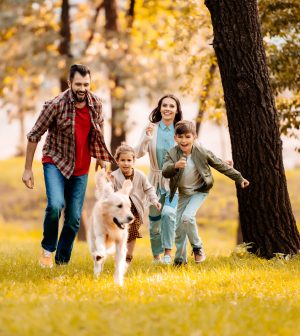- Navigating Your Midlife Crisis: Embracing New Possibilities
- City Raccoons Showing Signs of Domestication
- Mapping the Exposome: Science Broadens Focus to Environmental Disease Triggers
- One Week Less on Social Media Linked to Better Mental Health
- Your Brain Changes in Stages as You Age, Study Finds
- Some Suicide Victims Show No Typical Warning Signs, Study Finds
- ByHeart Formula Faces Lawsuits After Babies Sickened With Botulism
- Switch to Vegan Diet Could Cut Your Greenhouse Gas Emissions in Half
- Regular Bedtime Does Wonders for Blood Pressure
- Dining Alone Could Mean Worse Nutrition for Seniors
Getting Kids Out in Nature Boosts Lung Health, Study Finds

Living next to nature may improve the function of little lungs.
Researchers studying kids’ exposure to green space found that those who had vegetation near their homes in the first 10 years of life performed better on a test of lung function than those who did not live near nature.
“Our research suggests the greener, the better,” said Diogo Queiroz Almeida, who studies genetic, behavioral and environmental determinants of health at the University of Porto in Portugal. “These improvements are modest at around 2%. However, if we look at the whole population, making our neighborhoods greener could have a considerable impact.”
For the study, researchers measured the lung function of nearly 3,300 Portuguese children, using a device that measures the maximum amount of air a person can exhale after taking in the deepest possible breath. The test can indicate how well the lungs are working and help diagnose conditions like asthma.
Researchers also used satellite data and maps to gauge the extent of vegetation close to their homes — for example, the distance to their nearest park, garden or public green space. They looked at that data from the time they were born, as well as when children were 4, 7 and 10 years of age.
Kids whose surroundings became greener between birth and their 10th birthday, either because they had moved or there were changes in their neighborhoods, tended to have better lung function, the study found.
The findings were published July 27 in the European Respiratory Journal.
“We looked at factors like physical activity and air pollution, but the link between lung function and moving closer to green space remained, even after we took these into account,” Queiroz Almeida said in a journal news release. “It could also be that getting closer to nature reduces stress, which can improve physical health, or it might have a positive effect on children’s microbiome — the community of different bacteria that live in our bodies.”
Only an association was seen between lung function and greener environments, and not a cause-and-effect link.
Queiroz Almeida said it seemed to matter more that kids lived in green neighborhoods as they grew up than if they lived there when they were born.
His team also studied living next to what’s known as “blue space,” such as rivers or the sea. They found no link with children’s lung health, but fewer than 1% of children in this study lived within a half-mile of blue space, so a link could not be ruled out for shorter distances.
Moving to greener areas may be one strategy to improve children’s lung function, Queiroz Almeida said. Yet many families may be unable to afford to live in greener neighborhoods.
“To reduce health inequalities, we need to make our cities greener, especially in areas where there is little or no green space,” he said, adding that it’s important to involve families to make sure parks and gardens suit their needs.
Researchers plan to continue to investigate role of green and blue spaces in other areas of children’s health. They plan to use focus groups to understand how and why younger people use green spaces.
“We know that early childhood is a crucial time for lungs to grow and develop, and that a child’s environment and the air they breathe can have an impact on their lung health for the rest of their life,” said Dr. Marielle Pijnenburg, head of the pediatric assembly of the European Respiratory Society. She reviewed the findings.
“This study suggests that making sure our children grow up close to parks, gardens and green spaces could help improve their lung health, although as the authors said the mechanisms for this are unknown and may be complex,” Pijnenburg said in the release. “This finding contributes to a growing number of studies that show health benefits of making our neighborhoods greener and healthier.”
More information
NASA has more on green space and health.
SOURCE: European Respiratory Journal, news release, July 27, 2022
Source: HealthDay
Copyright © 2025 HealthDay. All rights reserved.










